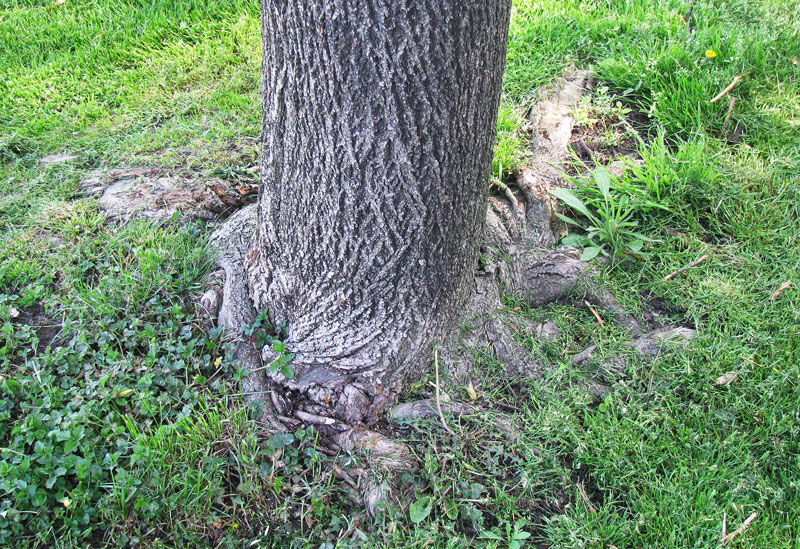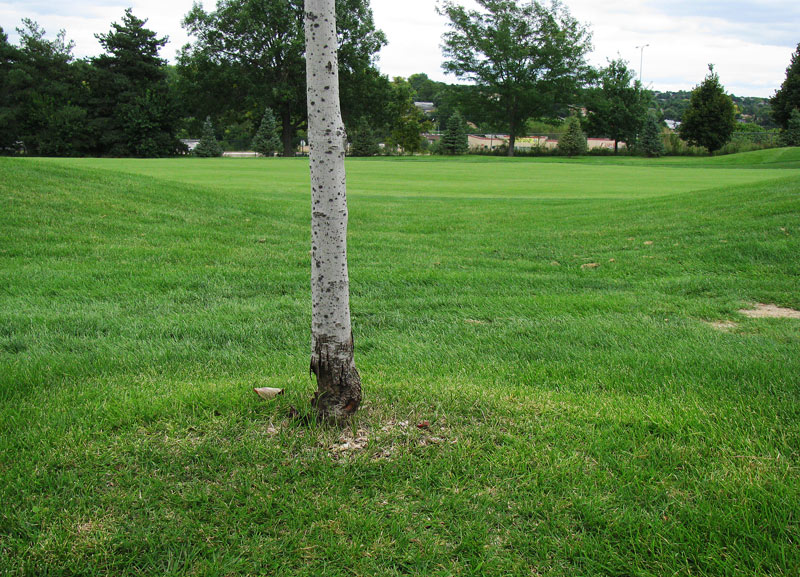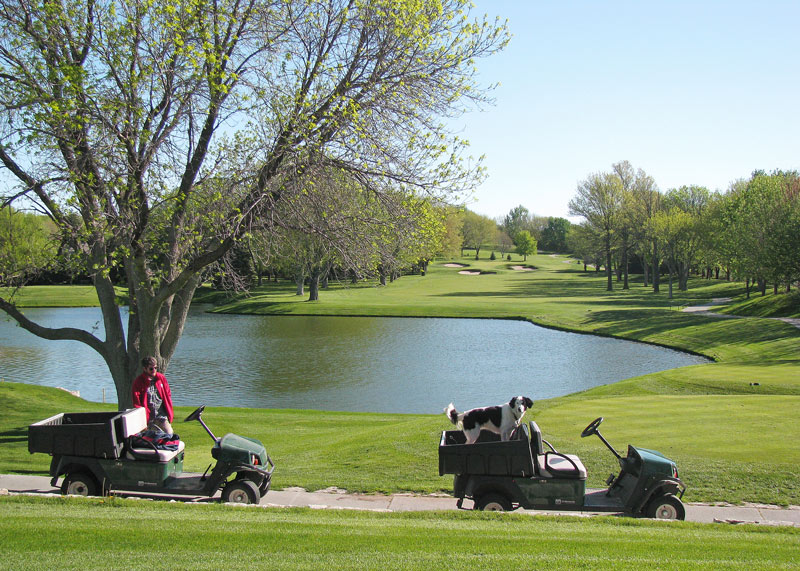
Spotting common tree defects, such as stem-girdling roots, can be handled by a certified arborist from an outside company, or can be the responsibility of a golf course employee designated as the tree care scout. Photos courtesy of John C. Fech
Ah, the plight of the golf course superintendent, responsible for all things “green” outside the clubhouse. Because priorities tend to dictate time, effort and money expenditures, lots of resources typically focus on greens, tees and fairways, and lesser amounts on the woody plants in the golfscape. Certainly understandable, although the trees and shrubs can’t take care of themselves. If they were left to do so, the course would quickly turn into a forest or nature preserve. Both are fine uses of natural space, but they don’t work too well as a functioning golf course.
Considering the superintendent’s focus on furnishing fine turfgrass, the best course of action may be to assign an individual (or group of individuals) on the staff to become trained in the care of trees, with safety, tree health and aesthetics as priorities. Another prudent approach is to transfer the responsibility for tree care maintenance to a company that works with trees day in and day out. As with many operational choices, there are pros and cons to each option.
Tree care companies: Pluses and minuses
When deciding whether to keep the important work of planting trees and keeping them healthy in-house or to pursue outside assistance, a superintendent has many factors to consider. Though there are likely more than the following concerns, these rise to the top.
Equipment costs. Given the initial outlay of cash needed for a boom truck and a tub grinder, the advantage goes to tree care companies on this one. In most cases, a lot of money and a small army of workers are required to buy, service and operate tree care equipment.
Availability of workers. If the workers work for the course, they tend to be more available to focus on the task at hand compared with workers from a company, who may be busy with pruning for a homeowners association or a college campus when you need them most. Score one for the home team.
Insurance and liability. This one may be a wash. Like renting an apartment where property taxes and insurance are usually disguised and included in the monthly rent as opposed to a traditional homeowner who pays them in a separate yearly invoice, the user pays one way or the other.
Training time, maintenance of credentials, and costs. As many superintendents can understand from becoming a Certified Golf Course Superintendent or striving to become one, the investment of time and energy in earning a certified arborist’s credential is significant, yet it’s certainly a worthwhile endeavor. It’s tough to say which has the advantage when it comes to training, as golf courses vary in their commitment to it, as do tree care companies.
Expertise of workers. Also a difficult consideration, with a slight nod to the tree care company. With pressure to gain the edge in the overall market, hiring and keeping workers with a strong set of skills and many years of experience is a constant focus of a tree care company owner, which usually translates into a benefit for the superintendent.
In-house tree care know-how
Whether the work is assigned to one of a course’s employees or transferred to a tree care company, it’s still the superintendent’s responsibility to know what needs to be done and what it should look like when the job is finished. If hiring a company is the chosen route, effective superintendents must be able to identify and select qualified arborists to perform essential preventive and restorative tree maintenance on their golf course.
As well, for the trees themselves, superintendents must be able to conduct a needs assessment. Specifically, superintendents should be able to determine the immediate needs of a given tree — whether it needs to be repaired, proactively cared for, removed or replaced. Though many if not most superintendents spend the majority of their time focused on turf, a certain baseline of tree knowledge is extremely useful. The ability to spot potential problems, or at least to be able to tell that a tree is expressing a certain symptom that looks like a problem, will be beneficial overall.
A sensible staffing plan may be to hire at least one tree care worker or arborist to the course’s workforce to communicate precise needs for tree maintenance to stakeholders, decision-makers and prospective arborists. These in-house employees may also be equipped to obtain bids, check credentials and evaluate the reputation of potential tree care companies. Though they wouldn’t be pruning, spraying and climbing, tree-focused course employees could identify and prioritize solutions for problem trees and outline an effective plant health care monitoring program throughout the year. Big picture, they can determine whether a tree is placed well and is thriving within the golfscape as it grows and matures, and as other changes are made to the land.
As you give thought to hiring an in-house worker, know you’ll get a distinct advantage if a staffer with a solid golf course maintenance background is chosen or reassigned from the existing crew. Because trees and turf are co-located in most cases and share the same soil and root zone, an understanding of the influences of golf turf maintenance on tree health is crucial to success. Such a worker would likely understand first-year tree care fundamentals as well as the process of identifying tree defects and hazards. The best arrangement would most likely entail close communication with the superintendent to discuss and explain needs for pruning, pest control and ongoing maintenance procedures.
Tree problems and problem look-alikes
Initially spotting a problem is the responsibility of the superintendent or the course’s tree care scout, while the actual preventive or restorative actions can be outsourced to a company that specializes in tree care. The classic maladies of mower blight, co-dominant leaders, leaning trees, cracks in trunks and branches, and decay in heartwood and sapwood are common for most tree species. Arborist or not, with a little investment of time and a head for curiosity, you’ll be able to spot such ailments and slate them for pertinent attention.

As with the bulk of tree care troubles, mower blight is far easier to prevent than it is to treat.
Other “problems” are not so easily detected. Some may look worrisome but in actuality are normal. Two categories of these are typically evident, the first consisting of hickory, eucalyptus, silver maple and sycamore trees with exfoliating or “platy” bark that naturally peels off by Mother Nature’s design. Then there’s white pine (and many others), whose needles turn yellow and fall off the tree in autumn.
Other problems are the result of the growing conditions where the tree is located on the course. Compacted soils, hillsides and parking lots can wreak havoc on the capacity of tree roots to extract sufficient moisture and nutrients, while trees planted too close to others compete for these essentials as well.
Both the basic and advanced issues bring to mind the notion of the car mechanic and the gonkulator. Those of us who are mechanically challenged wouldn’t know the difference between a radiator and a gonkulator, but thanks to the magic of the internet, an in-house tree worker can, with just a few keystrokes, at least determine which concerns are legitimate, which are not, and what the real defects look like.
Communicating with arborists
The ideal relationship with a tree care company would include several key elements — the joint formation of a monitoring plan to scout problematic trees and conduct routine inspections, regular discussions with in-house scouts and superintendents, and the development of an overall philosophy of integrated pest management/plant health care. (“Plant health care” is a tree care industry version of turfgrass’s integrated pest management, with specific considerations for woody plants.)
When creating a protocol for a company’s services, it’s best to begin with preventive, scheduled inspections for plant health. A good approach is to greet the diagnostician with a handshake, a golf cart, and a cell phone number the person can call if questions of a directional or historical nature arise. If feasible, accompany the diagnostician on the first couple of inspection visits to provide background information that may not be immediately obvious, such as renovation efforts, soil additions and irrigation coverage.
The tree inspector should jot down notes on the condition of each tree inspected. The form for chronicling all of this should be generated based on his or her own experiences and then adapted by a golf course employee for localized conditions. A common form layout is a simple set of comments on each part of the tree’s structure (see a sample template for a tree inspection report). The form has sections for observations and recommended future remediation actions. After each visit, a copy of the report should be filed with the superintendent for a record of actions taken.

Proactively addressing potential tree care concerns, such as canopy encroachment, will serve your golf course well in the long term.
A plan of lesser involvement is the “Call me with questions or big problems” tactic. This approach is reactive, not proactive, and, as such, it usually results in reduced efficacy. With woody plants, preventing problems is much, much easier than curing them, especially considering the length of time required for a tree to grow to a valuable size. The analogy of pushing a big rock up a steep hill vs. rolling a stone down a slope applies here.
Convincing and choosing
Working with tree care companies and developing scouting/monitoring/action plans might be a new venture for some golf courses. If so, convincing stakeholders such as green committee members, city council representatives or owners may be necessary. In order to increase the odds of approval, project the prices of preventive action vs. curative treatments and removals. Along with foreseeable costs are the potential costs of litigation and lawsuits in cases where trees may fail and cause damage to property or people. Preparing for interactions with decision-makers can take on various forms, from role-playing with other staffers to flow charts and PowerPoint presentations. In any case, frank, honest and open discussions will go a long way toward achieving desired results.
As with most things in life, you get what you pay for. And in this endeavor, credentials and experience are worth their cost if you receive the green light to work with a tree care company. Given that the heart of working with tree care companies in a proactive fashion is diagnostic in nature, the certification of an arborist by the International Society of Arboriculture (ISA) is a good measure of competency. When issues of tree risk are to be evaluated, arborists who hold the Tree Risk Assessment Qualification (TRAQ) from the ISA should be involved with the assessment. This additional distinction is centered on the individual arborist’s capacity to evaluate considerations of health and vigor, liability of the owner, and the potential for and consequences of tree failure.
The selection process for a tree company can follow the track that has proved successful for past projects or processes on the golf course in which detailed bids, credentials, insurance, reputation and referrals are considered. The difference in this scenario is the focus on diagnostic ability and the need for an arborist who has the TRAQ designation.
John C. Fech is a horticulturist and ISA-certified arborist with the University of Nebraska-Lincoln Extension. He is a frequent contributor to GCM.